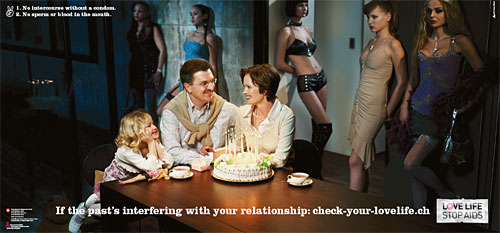Campaign urges people to take Aids test

A new Swiss anti-Aids campaign is urging people to take an HIV test if they have any doubts about their past sexual encounters.
Organised by the Swiss Aids Foundation and Federal Health Office, it calls on people to take the necessary precautions before embarking on a new relationship to minimise the risk of infection.
“Remember that when you meet a new partner, you will be having sex with his or her past. This is the message that we want to convey with the posters in our Love Life – Stop Aids campaign,” said Roger Staub, head of the Health Office’s Aids unit.
One of the three posters used in this year’s campaign, launched earlier this week, shows a family – small girl, mother and father.
But five women, who look like prostitutes, can be seen in the background of the picture.
The other posters show a heterosexual couple in a bath and a homosexual couple in the bedroom – both surrounded by previous lovers.
“When the past becomes a risk to the relationship people should ask themselves whether it is necessary to take the test,” Staub said.
Questionnaire
People can find out if they should take the test, based on their sexual habits, by completing a simple scientifically prepared questionnaire on the Check-your-lovelife.ch website.
“We have created a simple but very precise tool that gives advice on taking the test,” Staub said.
He said HIV detection had more prominence than in past campaigns.
“This year’s campaign has raised the question of previous sexual encounters and therefore we couldn’t avoid bringing up the test, which is the only sure way somebody can quash any doubts of a possible infection,” Staub said.
He said that the aim was not to increase the number of tests being taken but to make groups at risk more aware.
“In the past we were careful about putting the test in the spotlight. Our priority is still to promote sexual attitudes that avoid the risk of infection,” said Staub.
“If we speak about tests, then it means that a risky sexual experience has already taken place, and that is not what we want.”
HIV and gay men
In recent years there has been a worrying increase in the number of HIV cases among gay men in – up 34 per cent in 2005 – which has led to some questioning of Health Office campaigns by gay organisations.
Staub stressed that specific prevention for different groups was not part of the Love Life – Stop Aids campaign.
“We have two major objectives: the first is to avoid a massive increase of the HIV virus among the general population. The second is to stop the increase in risk groups.
“We want to reach the first objective with this campaign without challenging the second,” he said.
The Health Office was getting its message across to gay men through different, channels, he said.
Campaign successes
The first Health Office anti-Aids campaign goes back to 1987 and Staub says there have been successes.
“After 20 years of campaigns, we can say that there has been no massive spread of Aids among the Swiss population. And this was one of our objectives,” Staub said.
“In the 1980s our departure point was not much different from that of Africa. The explosion of the virus in this continent shows what could happen without prevention,” he said.
Staub says that Swiss campaigns are also envied abroad. “People abroad admire us for the non-moralistic and clear language we use, and for choosing courageous images,” he said.
But he admits that it is difficult at times to find the right balance.
“The secret of a campaign funded by taxpayers’ money is to irritate people enough for them to take notice, but without exaggerating, and to avoid our funding being cut. We have always operated on the limits of tolerance.”
swissinfo, based on an Italian article by Andrea Tognina
A person infected with the HIV virus is said to be HIV positive and may not show any symptoms.
If a person has Aids, he or she is infected with HIV and has signs and symptoms of the disease.
HIV is the virus while Aids is the disease that it causes. There is no cure.
The first case of Aids in Switzerland, diagnosed posthumously, was in 1981. Cases reached a peak of around 700 a year in the early 1990s.
The number of new Aids cases has now dropped to around 210 to 240 per year. In 2006, there were an estimated 150 new cases.
Since 2000 the number of people testing HIV positive has been rising (580 in 2000), with 750 diagnoses last year.
The increase was mainly among gay and bisexual men, with a decrease among drug addicts and heterosexuals.
Aids cases numbered 8,588 by the end of 2006. 5,669 people have died of the disease in Switzerland.
Around 25 million people are thought to have died of Aids worldwide.

In compliance with the JTI standards
More: SWI swissinfo.ch certified by the Journalism Trust Initiative


You can find an overview of ongoing debates with our journalists here. Please join us!
If you want to start a conversation about a topic raised in this article or want to report factual errors, email us at english@swissinfo.ch.